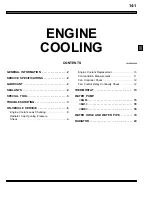
T
he purpose of engine lubrication system is to continuously deliver lubricating oil onto various kinematic pairs’ surfaces
so as to reduce friction and abrasion between relatively kinematic parts, thereby enabling them to work normally. In
addition, the flowing lubrication oil can perform many other functions, including chip removal, cooling, sealing and rust
protection. Engine’s lubrication system consists mainly of oil sump, coarse oil filter, oil pump, oil filter, oil dipstick, oil
gallery, oilhole, and some sealing parts. Engine adopts mixed lubrication methods, including forced lubrication and splash
lubrication. Forced lubrication is used for the following kinematic pairs: main journal and bearing of the crankshaft,
connecting rod journal and bearing of the crankshaft, piston pin and key seat, camshaft and bearing, etc., because these
parts have high load and their relative velocities are also high, therefore needing a certain pressure to deliver lubricating
oil into their clearances to form oil films; while splash lubrication is used for naked or light-load cylinder walls, cam surface,
tappet valve, etc.
lubrication system is shown in Fig. 294. The tamdem-
connection mode is used for the main oil gallery
between the engine oil filter and the cylinder block, thus
ensuring its good lubrication performance. When the
engine is running, the lubrication oil from the oil sump
enters through the coarse oil filter into the oil pump, and
then goes out of the oil pump into the main oil gallery
with a very high pressure, and then passes through the
engine oil filter for thorough elimination of very small
metal scraps and feculence. Afterwards, the finely
filtered oil enters into the main oil duct within the cylinder
block. On the main oil duct, the engine oil pressure
switches are tandem placed so as to issue warning
when the lubrication oil pressure is too low. The engine
oil entering into the main oil passage has two directions.
One path goes downward to reach five bearing seats in
the cylinder block. This lubricates not only the
crankshaft’s main journal and bearing but also the
connecting rod’s journal and bearing (the engine oil
enters along the oil passage from the journal to the
connecting rod’s into the clearance between the
connecting rod’s journal and bearing), and furthermore
the lubricating oil squeezed out can also be used with
that splashed by the crank arm rotation for splash
Chapter 9 Lubrication System
1. Oil Passage within Lubrication System
Section 1 Makeup and Features of Lubrication System
Fig. 294 Flow chart for engine’s lubrication system
Primary
journal
Main oil
gallery
Bearing
Primary
journal
Main oil
gallery
Bearing
The crankshaft’s
No.1, No. 2, No. 3,
No. 4, and No. 5
main shaft necks
Pressure
relief
valve
The
crankshaft’
s No.1, No.
2, No. 3,
No. 4, and
No. 5
connecting
rod’s
journals
Primary
camshaft
bearing
near inlet
Primary
camshaft
bearing
near outlet
When the
pressure
reaches
0.49MPa,
the valve is
opened.
Cylinder wall
Piston pin
Coarse
cleaner
Valve
Tappet
Cam
Valve
Tappet
Cam
Oil sump
Driving
gear,
driven
gear and
equipment
gear
Engine
oil
pump
The engine oil goes
upwards along the
cylinder head’s
connection bolt
washers
Oil pressure
Filte
Bypass
Splash
Forced
Engine oil
132
Содержание JL481Q
Страница 1: ......
Страница 9: ...5 Fig 3 Components Assembly Drawing of MR479Q MR479QA Engine ...
Страница 10: ...6 Fig 4 MR479Q MR479QA Engine and Its Power System ...
Страница 11: ...7 Fig 5 Assembly Drawing of Engine and Its Auxiliaries MR479Q MR479QA ...
Страница 12: ...8 Fig 6 Electronic Control Fuel Injection System in Engine MR479Q MR479QA ...
Страница 13: ...9 Fig 7 Front view of Engine JL481Q MR481QA ...
Страница 14: ...10 Fig 8 Sectional elevation of Engine JL481Q MR481QA ...
Страница 15: ...11 Fig 9 Electronic Control Fuel Injection System in Engine JL481Q MR481QA ...
Страница 21: ...17 Fig 13 Exterior Feature of JL481Q Engine Power Me N m Torque Pe Kw ge g kwh Fuel Consumption Ratio ...
















































